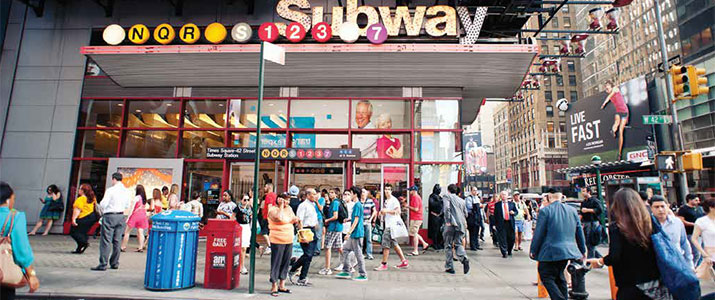
Meeting The Challenge
Surveillance technology evolves in today's expansive public transportation system
- By Greg Peratt
- Jul 01, 2013
 Today’s society is dependent on transportation systems to keep every
day running smoothly and efficiently. Public transportation systems
like buses and trains impact millions of people and serve as a vital
part of our economy, generating millions in tolls and fares. In large
cities, public transportation is so widely used that any delays or inefficiencies
have a tremendous impact on users’ day-to-day lives.
Today’s society is dependent on transportation systems to keep every
day running smoothly and efficiently. Public transportation systems
like buses and trains impact millions of people and serve as a vital
part of our economy, generating millions in tolls and fares. In large
cities, public transportation is so widely used that any delays or inefficiencies
have a tremendous impact on users’ day-to-day lives.
Ridership on U.S. public transportation is now growing faster than ever, according
to the American Public Transportation Association. In 2012, 10.5 billion
trips were taken on U.S. public transportation—154 million more than the previous
year, a record growth. As the volume of passengers continues to grow, so does
the reach of today’s general mass transportation.
The United States’ subway and rail systems are made up of more than 3,200
stations and 20,000 miles of track running nationwide. To provide safety for users
and protect system assets, public transportation services are looking at costefficient
security solutions that can meet their growing needs.
After 9/11 and the recent bombings in Boston, the issue of security has become
an increasingly pressing matter across the country. Immediately after the Boston
bombings, no suspect had been identified.
Fortunately, a surveillance camera at a nearby store captured footage that led to
the identification of two suspects, which allowed police to release images of both
men to the public within days of the incident. With no other evidence available at the
time, video surveillance technology saved precious time and made identification possible.
Without the aid of this surveillance tool, these critical images would not have
been possible. It was an HD thermal-energy camera that helped law enforcement
capture one of the suspects later in the week and bring him into custody. Without
these advanced security technologies, the outcome may have been very different.
The events on 9/11 had an enormous impact on the level of security measures
implemented in the United States. After this incident, the Transportation Security
Administration (TSA) was formed, and the government began ramping up airline
security with both budget and manpower. Screening measures now look at everything
from bags and packages to liquids and even shoes. Sometimes passengers are
randomly selected for additional screening procedures. With advanced imaging
technology, authorities can screen contents of bags and use metal detectors to
search for suspicious items.
Despite a growing and continued focus
on air travel security measures, mass
transit security funding has not kept
up. While many have called for Washington
to significantly increase funding
for public transportation security, federal
investment in this area actually decreased
by 65 percent from 2010 to 2012,
according to the transit association.
TSA has allotted almost four times
the budget for aviation security than
it has for surface transportation security.
This year the TSA budget set aside
$124.3 million for surface transportation
security, down from $134.7 million
in fiscal 2012.
The Department of Homeland
Security’s Transit Security Grant
Program, a major source of security
funding for municipal transit systems,
reduced its funding from $200 million
in fiscal 2011 to $87.5 million in fiscal
2012. States and municipalities, hindered
by years of economic recession,
have been unable to fill the funding gap,
leaving employees, passengers and transit
infrastructure unprotected.
Recent events including the Boston
Marathon bombing have brought renewed
attention to security in public
areas, including open public transit systems.
Sadly, this is only one of several
such terrorist attacks in recent years in
which public gatherings and mass transit
were targeted. Other examples of
attacks on transit systems include the
coordinated rush-hour attack in London
subways and a double-decker bus,
killing 37 people.
A year earlier, 10 bombs exploded
on trains in Madrid, killing 191 people
and wounding another 1,500. Earlier
this year, Canadian officials foiled a
terrorist plot to use a bomb to derail a
passenger train in the greater Toronto
area. But terrorist attacks are only one
concern related to mass transit security.
Every day, mass transit employees and
riders face thefts, mugging, vandalism
and other safety hazards. From capturing
criminals to monitoring the safety
of passengers who walk in dangerous
areas, employing the proper security
measures is increasingly important.
With tight budgets and fewer resources
available to monitor and manage
daily operations, there is a simple
and cost-effective solution for companies
providing mass general transit:
video surveillance. Video surveillance
has proven to be one of the most effective
forms of security, and many transportation
systems are now using cameras
to record incidents that occur on
buses and trains. Video surveillance has
evolved drastically over the past decade
and technology advancements are now
accommodating the needs of general
transit providers.
Surveillance Capabilities
Today’s surveillance cameras offer
many benefits. Compact sizes offer a
discreet way to effectively monitor what
is happening on and around trains and
buses. By making the cameras less obvious
to the public, authorities are able
to capture all incidents without alerting
suspects that they are being filmed.
These small cameras are controlled
remotely, equipping them with highquality
zoom capabilities.
Rather than looking at what used to
be a small grainy image, today’s cameras
can zoom to focus on tiny details that
older versions may not have been able
to detect. Critical evidence sometimes
relies on the most minute details, which
can now be clearly recorded thanks
to today’s video surveillance technology.
Additionally, cameras are now also
equipped with wide viewing angles, providing
a greater range of coverage that
allows the cameras to capture more incidents
while making it more difficult for
people to step outside the frame of view.
Since the camera can adjust and move if
necessary, officials can obtain more accurate
evidence.
Perhaps one of the biggest ways this
type of technology has advanced is
through its wireless capabilities. Before
these newer solutions were available,
bus drivers would return to the station
or depot and physically remove the
hard drive from the system and download
the footage for viewing or save
onto local servers. This was a time consuming
and laborious process. Today’s
technology is much more efficient. New
local recording options can be utilized,
or wireless capabilities can allow footage
to automatically upload onto system
servers as soon as the bus pulls into
the station, saving time and improving
the availability and access of reliable
footage. As a result, video footage can
be managed and reviewed much more
efficiently than in the past.
The quality of video footage has also
made significant leaps. In the past, security
camera images were often grainy
and distorted, making it difficult to distinguish
people, let alone specific facial
features. Higher quality footage shows
greater detail like distinguishing marks
and other identifiers. These clearer images
capture features that were once unavailable
and are now being leveraged as
evidence and assisting law enforcement
in making prosecution easier. Increasingly
powerful, it is now a common camera
feature capable of providing clean
crisp images that leaves little to no room
for doubt. Many of these same products
also offer low light/nighttime viewing
capabilities for better image quality in
the dark and in poorly lighted areas.
High-quality surveillance footage,
and the knowledge that security cameras
are present, is also aiding companies
when dealing with vandalism. Vandalism
is a common and costly problem on
buses and trains but has been difficult to
prevent. However, the presence of video
surveillance cameras reduces the number
of incidents and can be used to deter
vandals and reduce these costs or capture
critical evidence to potentially aid
in the prosecution of vandalism suspects.
Evolving Technology
As video analytics capabilities continue
to advance, mass transit systems will be
able to use them as critical tools in helping
to keep public transportation systems
safe. For example, developing facesearch
technology would allow security
personnel to conduct high-speed searches
within surveillance footage to find a
suspect’s face based on a single reference
face. With this capability, transit authorities
could quickly look through old
footage to find all instances of a suspect
appearing in that footage. At some point
in the future, this technology would also
be capable of recognizing when a reference
picture of a suspect’s face passes
a live camera, allowing authorities to
be alerted when a known or dangerous
suspect has entered a station, attempts
to enter a subway car or bus, or is simply
spotted in the crowd.
These evolving security capabilities
are saving public transportation a great
deal of money during a time when budget
cuts and reductions in staff are quite
common. Video surveillance technologies
enable transit providers to have eyes
on every bus or train, preventing theft
and violence and providing critical evidence
when needed. Most importantly,
these surveillance cameras are providing
a safer and more secure environment for
passengers and employees.
With so many technologies available,
security products are continuing to
evolve to keep up with the safety needs
of mass transit. Every day these systems
are processing millions of hours
of surveillance data that enables managers
to make better decisions about
passenger safety. As our technology capabilities
become more sophisticated,
authorities will continue to integrate
state-of-the-art capabilities into transit
systems to provide the most advanced
security available.
This article originally appeared in the July 2013 issue of Security Today.